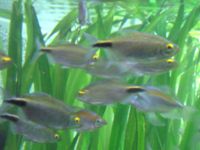|
Characiformes |

Brycinus longipinnis
|
|
Scientific classification |
|
|
|
Families |
Acestrorhynchidae
Alestiidae - African tetra
Anostomidae - Headstander
Characidae - Characin and tetra
Chilodontidae
Citharinidae
Crenuchidae
Ctenoluciidae - Pike-characid
Curimatidae
Cynodontidae
Distichodontidae
Erythrinidae - Trahira
Gasteropelecidae - Freshwater hatchetfish
Hemiodontidae
Hepsetidae
Lebiasinidae
Parodontidae
Prochilodontidae
Salminopsidae (extinct)
Serrasalmidae |
The Characiformes are an order of
ray-finned fish, comprising the characins and their
allies. There are a few thousand different species,
including the well-known
piranha and
tetras.
These belong within the superorder Ostariophysi, a group
mainly distinguished by the presence of a Weberian
apparatus, a series of bony parts connecting the swim
bladder and inner ear. Superficially the Characiformes
somewhat resemble their relatives the minnows. The most noticeable differences are the
presence of a small fleshy adipose fin between the dorsal
fin and tail, and the presence of teeth within the mouth,
though there are exceptions to both of these.
Barbels are always absent and the body is almost always
covered in well-defined scales.
Characins are found in tropical lakes and rivers
throughout most of South America, Central America, and
central Africa. This and other evidence suggests they first
diversified during the Cretaceous period, though fossils are poorly known. A
few characins become quite large, and are important as food
or game. Most, however, are small shoaling fish. Many
species are popular in aquaria thanks to their bright
colors, general hardiness, and tolerance towards other fish
in community tanks.
Originally the characins were all grouped within a single
family, the
Characidae, which was included in the
Cypriniformes. Since then about 15 different families
have been separated out. However, classification varies
somewhat, and it appears the circumscribed Characidae are
still
polyphyletic.




